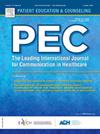How can healthcare professionals promote pulmonary rehabilitation in people with COPD? A qualitative study
IF 2.9
2区 医学
Q2 PUBLIC, ENVIRONMENTAL & OCCUPATIONAL HEALTH
引用次数: 0
Abstract
Objective
Despite the evidence for pulmonary rehabilitation programs (PRPs) in people with chronic obstructive pulmonary disease (COPD), uptake of this intervention is suboptimal. Our group recently noted novel barriers to the uptake of PRPs in people with COPD, such as feeling unworthy of healthcare. Little is known about factors that contribute to this feeling. We explored autobiographical experiences of the interaction between HCPs and people with COPD at the time a PRP was recommended as an appropriate intervention.
Methods
This qualitative study was guided by a critical realist perspective. Both HCPs and people with COPD were recruited from tertiary hospitals. Questions were based on the theoretical domains framework and explored the determinants of behaviour related to initiating a referral to a PRP and the person with COPD enrolling in a program. Interview transcripts were analysed using reflexive thematic analysis.
Results
Data were available on 15 participants with COPD and 38 HCPs. The first theme was that the HCP needed to care for the person and not just treat a disease. Subthemes pertained to language and behaviours of the HCP including, (i) actively listening, (ii) demonstrating genuine empathy, (iii) establishing trust and, (iv) empowering the person with COPD to engage in shared decision-making. The second theme was that the HCP needed to instil hope that pulmonary rehabilitation would benefit the person with COPD. Subthemes comprised; (i) enthusiasm of the referrer and sharing their vicarious experiences that PRPs have helped others, (ii) describing the intervention, allaying fears and personalising a positive outcome following program completion, (iii) having a physician endorse the PRP, (iv) using terms other than ‘pulmonary rehabilitation’.
Conclusions
These data provide a blueprint for interactions in which HCPs can foster people with COPD to accept a referral to a PRP, in a manner that translates to enrolment in a program.
卫生保健专业人员如何促进COPD患者的肺康复?定性研究
尽管有证据表明肺康复计划(PRPs)可用于慢性阻塞性肺疾病(COPD)患者,但该干预措施的应用并不理想。我们的小组最近注意到COPD患者服用PRPs的新障碍,例如感觉不值得医疗保健。人们对造成这种感觉的因素知之甚少。我们探索了在推荐PRP作为适当干预措施时HCPs与COPD患者之间相互作用的自传式经验。方法采用批判现实主义视角进行定性研究。HCPs和COPD患者均从三级医院招募。问题基于理论领域框架,并探讨了与开始转介到PRP和COPD患者参加计划相关的行为决定因素。访谈记录使用反身性主题分析进行分析。结果:15名COPD患者和38名HCPs患者的数据可用。第一个主题是HCP需要照顾人,而不仅仅是治疗疾病。副主题与HCP的语言和行为有关,包括:(i)积极倾听,(ii)表现出真正的同理心,(iii)建立信任,(iv)授权COPD患者参与共同决策。第二个主题是HCP需要灌输肺部康复将使COPD患者受益的希望。Subthemes组成;(i)转诊者的热情并分享PRP帮助他人的替代经验,(ii)描述干预,减轻恐惧并个性化项目完成后的积极结果,(iii)有医生认可PRP, (iv)使用“肺部康复”以外的术语。结论:这些数据为HCPs促进COPD患者接受转介至PRP的互动提供了蓝图,从而转化为项目的注册。
本文章由计算机程序翻译,如有差异,请以英文原文为准。
求助全文
约1分钟内获得全文
求助全文
来源期刊

Patient Education and Counseling
医学-公共卫生、环境卫生与职业卫生
CiteScore
5.60
自引率
11.40%
发文量
384
审稿时长
46 days
期刊介绍:
Patient Education and Counseling is an interdisciplinary, international journal for patient education and health promotion researchers, managers and clinicians. The journal seeks to explore and elucidate the educational, counseling and communication models in health care. Its aim is to provide a forum for fundamental as well as applied research, and to promote the study of organizational issues involved with the delivery of patient education, counseling, health promotion services and training models in improving communication between providers and patients.
 求助内容:
求助内容: 应助结果提醒方式:
应助结果提醒方式:


